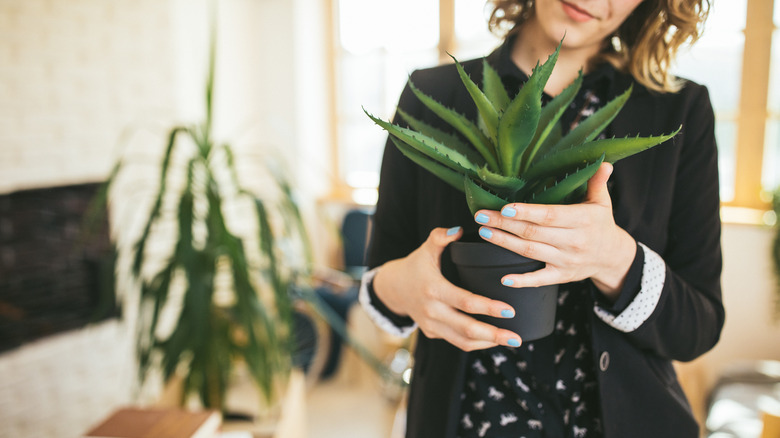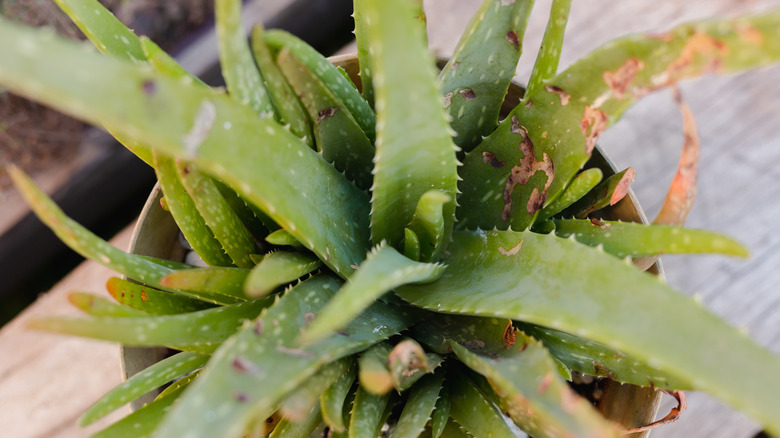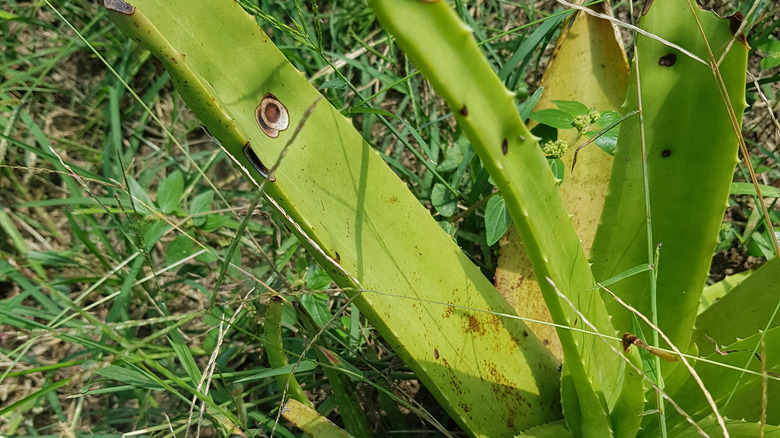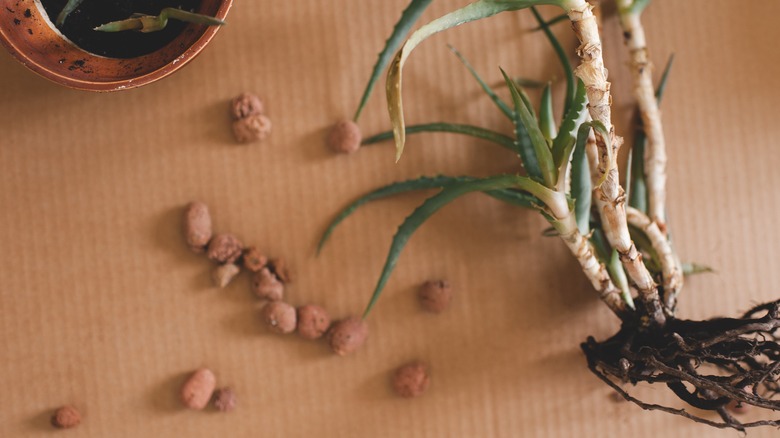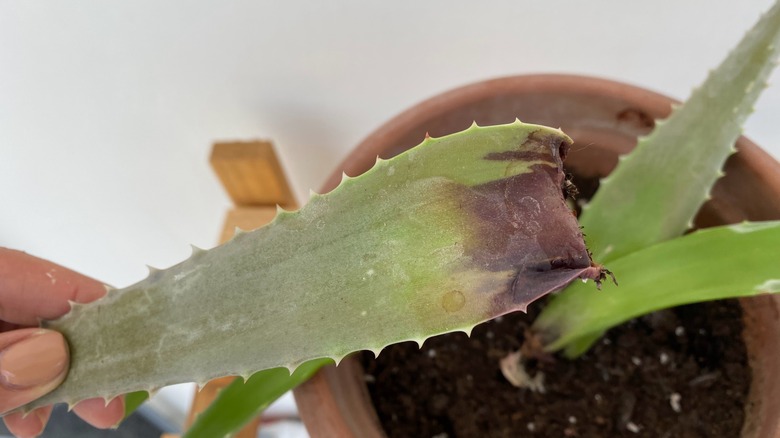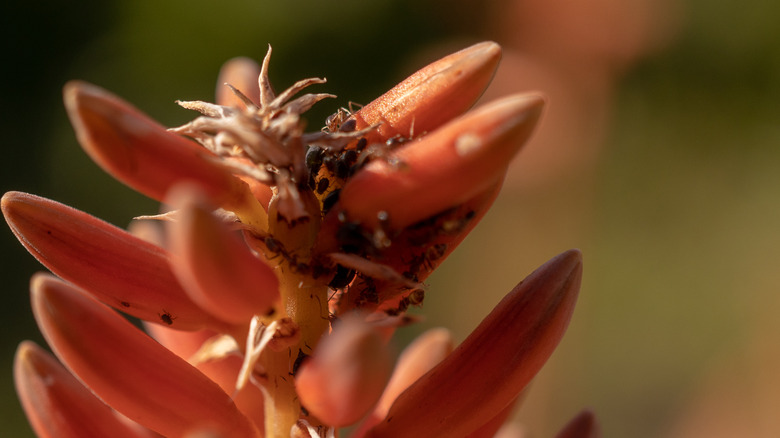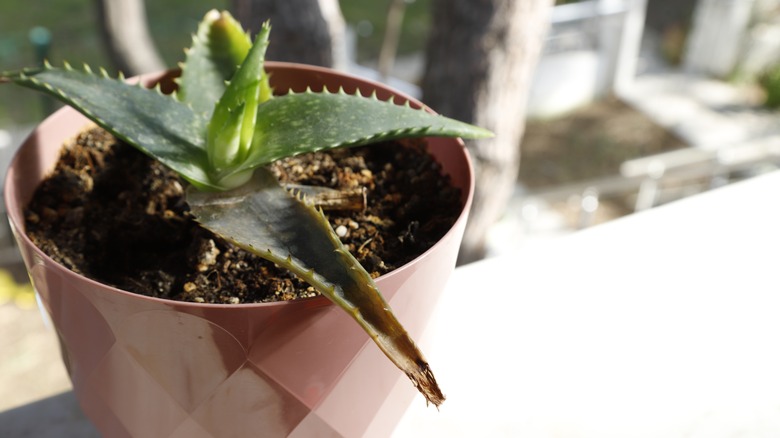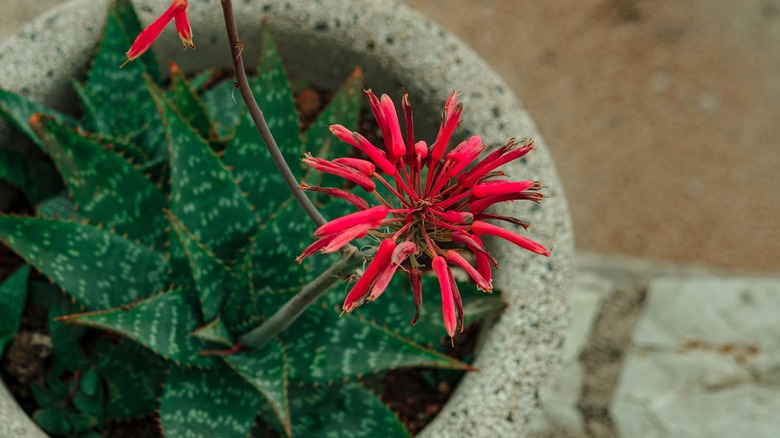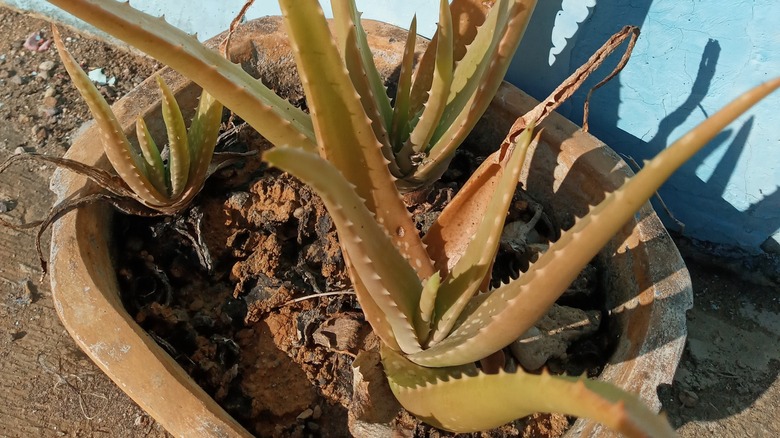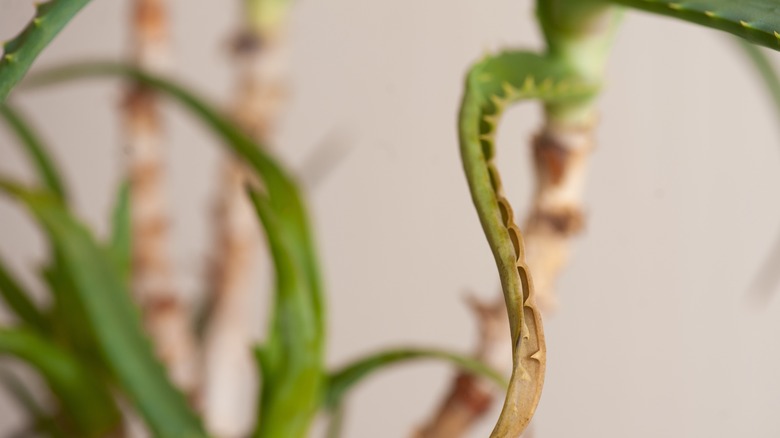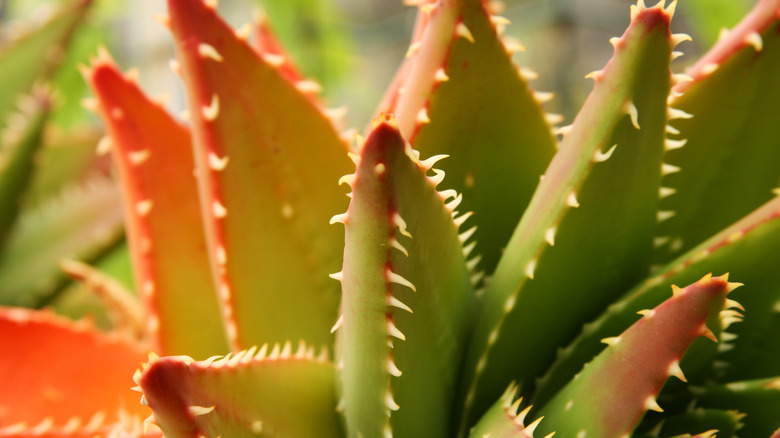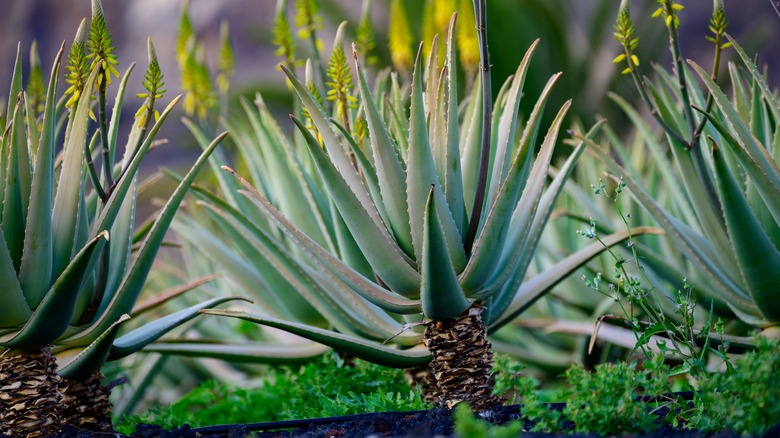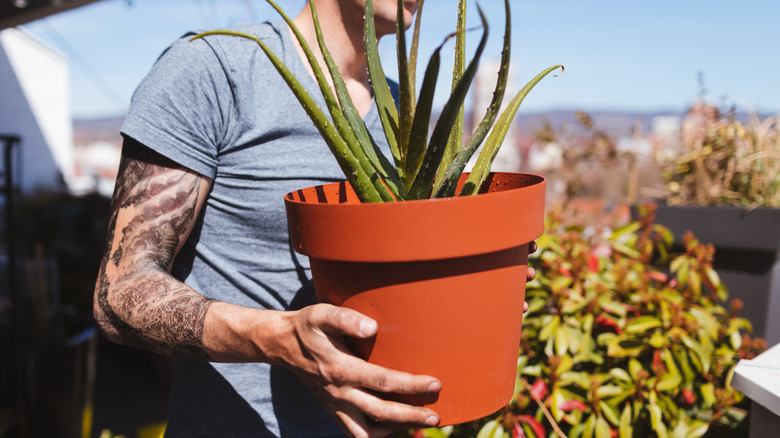12 Common Aloe Plant Issues To Keep An Eye On
Known for its hardiness and tolerance to inadequate growing conditions, aloe is the dream plant of the novice gardener. With or without a green thumb, you can correctly grow and take care of aloe vera plants in the garden or as a houseplant. But there's a catch. For all its famed toughness, the beautiful succulent sometimes succumbs to unexpected elements beyond your control. Pests and pathogens can cause enough damage to the meaty leaves and tarnish their beauty with spots, discoloration, or bend them out of shape. In extreme cases, they could kill the plant altogether.
While the succulent is touted as resilient and low-maintenance, neglect and poor care practices can have devastating effects on its health and growth. Luckily, though, aloe plants are nothing if not tough as nails. With the proper treatment, many of these care and maintenance problems can be fixed and reversed. Read more to discover what to do when encountering any of these common aloe plant issues.
Aloe rust
Healthy aloe plants have meaty leaves with taut and flawless skin, but when tiny yellow circles appear on the top side of them, you have every reason to be alarmed. The pale blemishes are hardly noticeable at first, but gradually expand and darken until they turn brown or black. Orange blemishes emerge on the underside of the leaves as well. This is aloe rust, a fungal infection, and these little orange piles are the spores of the fungus. As the disease progresses, the infected leaves will wither and fall. The fungus spores are carried by the wind and infect the succulent in humid conditions with moderate temperatures between 60 and 82 degrees Fahrenheit.
Aloe rust isn't a lethal disease, nor does it spread. Once the spores land on the surface of a leaf, they infect it, but won't jump to another leaf or plant. That makes your job of containing the disease easier. The best course of action is to remove the affected leaves and dispose of them safely. Keeping the plant well-ventilated and following proper watering practices will minimize the risk of infection. A temperature of 86 degrees Fahrenheit and above keeps the aloe safe from this fungal disease, but that may not be possible for an indoor plant.
Leaf blight
Anthracnose, or leaf blight, is another fungal infection that targets the leaves of aloe plants during different stages of their development. Symptoms of the disease include water-soaked oval bubbles on the surface of the leaves. These dark green lesions will turn brown or pink and take a perfectly circular shape. The pink dots are the maturing spores ready to infect other parts of the plant or other succulents. Eventually, the lesions join together to form large patches on the waxy leaves. Leaf blight thrives in warm and humid conditions and wet leaves are more prone to infection.
To combat anthracnose, spray the succulents with fungicides such as Bordeaux Mix, Tilt, or Folicur. The dosage and frequency of application vary depending on the severity of infestation and the type of fungicide, so always read the instructions on the label. Managing the fungal infection can be less effective than implementing preventive measures against the disease. Avoid getting the leaves of the succulent wet and improve ventilation around it. As an additional precaution, don't keep the potted aloe near plants infected with leaf blight, especially during the rainy season. Rain splashes could transport the spores to healthy plants.
Root and stem rot
Rot is a common issue for many varieties of succulents, and, with aloe, two types of rot infect the plant and can be detrimental to its health and growth. These are root and stem rot. Root rot is the stealthier of the two since the roots are hidden underground, but telltale symptoms, such as the leaves changing color, wilting, and falling off, coupled with a foul odor and stunted growth, all point to the underlying rot. If you dig up the root ball, you'll find it has turned black and become mushy. The disease is caused by fungus and bacteria infections, especially if the plant sits in waterlogged soil for too long. In severe cases, the rot will progress from the roots and infect the stem of the plant. Stem rot is exacerbated by damp and cold conditions.
Repotting the infected aloe is the only way to save the succulent. After extracting the plant, examine the root system and trim off rotting and dead roots. Transplant it into a new pot with drainage holes and use fresh soil. In the case of stem rot, take a healthy cutting from the stem to propagate the plant. To avoid future recurrence of the deadly diseases, don't overwater the aloe and allow the soil to dry out between irrigations.
Soft rot
Even though harvesting your own aloe vera is easier than you'd think, there still are, as we've been discussing, issues you may encounter. One of those problems is watery, rotting leaves. When the waxy firm leaves become squishy and soggy, you're looking at soft rot disease. Caused by bacteria, the rot targets both young and adult leaves. The adult leaves turn dark and, as the rot generates gases, they become swollen. Young leaves wilt and collapse. If you pull an infected leaf, it will come off the stem easily. The bacteria live in the soil and enter the plant via the roots. Hot and humid conditions trigger the disease in the succulents.
If the plant displays symptoms of soft rot disease, you should destroy it to prevent the spread of the lethal disease. Making the environment as inhospitable as possible for the pathogen is the ideal way to avoid such infections. Since aloe is drought-tolerant, allowing the soil to dry out will keep the disease at bay. Also, get rid of any debris in the soil where the bacteria might hide.
Aphids and sooty mold
While aloe vera aphids are just one of quite a few pests that attack aloes, they're by far the most destructive. They have an oval body that's either green or orange-brown and covered with a thin layer of white wax. Aloe vera aphids live around the base and rolled tips of the leaves, where they feed and hide from predators. In large numbers, they can cause severe damage to the succulents. Sooty mold and aphid infestations go hand in hand. The fungal disease develops on the trail of honeydew that the bugs deposit on the leaves. Neither the pests nor the sooty mold are lethal to aloes, but they can stunt the plant's growth and diminish its natural beauty.
You can always keep aphids off your aloe plant with dish soap diluted in water and sprayed on the infested succulents. Another easy option is to turn your garden hose on the bugs. The strong water stream dislodges the insects and sends them to the ground, where they become easy prey to predators. (Just be sure you don't damage the plant by spraying it too forcefully.) Speaking of predators, allowing ladybugs, parasitic wasps, earwigs, and predatory beetles into the garden will get rid of the aloe vera aphid problem with little hassle.
Yellow leaves
Aloe vera leaves come in shades of light green or bluish-green. Any deviation from those two natural color gradients spells trouble for the succulent. Yellowing aloe leaves are symptoms of a wide array of unfavorable growing conditions and stressors that the plant might be experiencing. Giving the succulent too much water or letting it sit in waterlogged soil can lead to pale leaves. Another cause is repotting the plant in a pot several sizes too large. Even with proper watering practices, a large pot has more moisture than the succulent can handle. Poor lighting can lead to yellow leaves as well. Indoor aloes should get at least six hours of sunlight a day. Sudden changes in the temperature and nutrient deficiency in the soil might also explain this bleached look.
Not all yellowing aloe leaves are cause for alarm. The leaf could be reaching the end of its natural life. Other than that, you need to avoid overwatering or underwatering the succulent. Allow the soil to dry out before you water it and move the pot to a windowsill to get direct sunlight. When repotting the aloe, use a pot just one size larger than the old one.
No flowers
Growing indoors, aloe vera isn't inclined to flower. While aloe in the garden is merrily sending out blooms to attract pollinators, the ones you keep as houseplants remain flowerless. The lack of blooming is often associated with age, light, temperature, and nutrients. A young plant will not produce blossoms until it matures after three to four years. The light and temperatures in most homes are not adequate to induce the succulent to bloom. Full sun exposure for six hours a day is mandatory for flowering. Also, the plant isn't naturally used to the almost stable temperatures inside the house. In its natural habitat, the daytime is hot and evenings are cool. Further, since flowering is resource intensive, the aloe won't bloom in poor soil.
To encourage the potted aloe to flower, start bringing it outside as soon as the weather warms up in the spring. Gradually harden the plant to partial, then full, sun to avoid sudden overexposure to the light. In the evening, bring it back inside. Feeding the soil with a balanced fertilizer at half strength (diluted with water) provides the succulent with the nutrients it needs to bloom. Apply the liquid fertilizer mixture twice a year, first in the spring and then during mid-summer.
Brown leaves and tip diebacks
Brown leaves and tip diebacks are two separate symptoms your aloe might experience, but both problems have to do with watering and sun and heat exposure. Overwatered plants exposed to the hot summer sun can see their leaf tips become watery, turn brown, and die. Those same factors, combined with cold drafts, drought, over-fertilizing, pests, and diseases, could cause the entire leaves, and not just the tips, to turn brown. Meanwhile, scales, mealybugs, and aphids suck the sap out of the leaves, leading to discoloration. Fungal infections, such as anthracnose and leaf spot, also give the aloe that rusty appearance.
While the succulent will not recover from the tip dieback, a few things could be done to reverse the brown coloring. Adjusting the watering patterns and quantities is an excellent step to remedy the moisture problems. At the peak of summer, bring the plant inside or provide it with shade. If it's cold drafts that are causing the browning, keep the pots in a sheltered area. Identifying and treating pest infestations and diseases as soon as you notice them can prevent the issue.
Droopy leaves
Aloe is admired for its upright growth habit. A droopy plant is a sign that something is wrong with the growing conditions. The reasons why your aloe plant is drooping are numerous. Since it is a drought-hardy succulent, then the first suspect has to be water. With too much or too little moisture in the soil, the plant loses its sturdy stature, and the leaves flop. The same goes for not getting enough light or being overexposed to too much of it. Excessive heat and cold weather could have a similar effect on the succulent as well, while being root-bound or having pest infestations will also give it that slumping demeanor.
If the plant is potted, turn over the pot and check that it has drainage holes and they're not sealed shut with soil. Roots sticking out of the holes are an indication that the aloe is root-bound and needs a pot one size larger. Constantly wet soil tells you that you're overwatering the plant and dry soil means it's not getting irrigated enough. Adjusting between those two extremes should revive the succulent. Keeping the aloe indoors when it's too hot or too cold outside will also solve the drooping problem.
Red leaves
One of the easiest signs of ill health to spot in the aloe is when the leaves turn red. A single leaf or the entire rosette can partially or fully change into a reddish hue. Your investigation should focus on how much light the succulent is exposed to. Too much sun is often the culprit behind the unsettling rosy shade, but being sunburnt isn't the only reason for aloe to reveal these untrue colors. Overlapping factors such as a change in environment, fast-release fertilizers, and transplant shock might complicate the discoloration dilemma with light brown tints.
A little blush or a touch of redness from sun exposure doesn't hurt a healthy aloe — only when the red tone is tainted with brownish gradients should you try to fix the problem. Help a newly-bought plant or, one you just moved outdoors, adjust to the new environment with gradual acclimation. Diluting liquid fertilizers down to 50% strength will avoid the stress of growth spurts. To help it get over transplant shock, avoid overwatering the soil and keep the succulent from direct sunlight.
Leggy stems
The aloe plant has a short stem and a full and bushy rosette, but when something goes wrong with the succulent, the stem can get too long. Whether you're growing aloe vera for medicinal purposes or as an ornamental succulent, an elongated stem and a caved-in center defeat either purpose. This issue is called etiolation. It reflects the plant's endeavor to stretch and get more light exposure. When the middle of the rosette collapses, legginess could indicate too much moisture in the stem due to overwatering.
Before you can fix the legginess of the succulent, you need to treat the causes of the problem. If the plant isn't getting much light, move it to a well-lit area basking in direct sunlight. Also, allow the top couple of inches of the soil to dry out between waterings. To knock the aloe back into shape, trim off the overgrown and discolored parts, along with any offshoots. Applying cinnamon to the cuts will protect them against infections.
Leaves that are bent out of shape
Sword-like and pointing to the sky, aloe leaves sometimes arch over slightly, but they should never bend out of shape. If they do, then you know something has gone awry. One of the main reasons those leaves are taking this bizarre posture is the lack of light. When the plant isn't getting enough sun, the leaves bend in search of a source of light. A container that is too tight or too big for the succulent can also affect the leaves' posture. Not enough space for the roots causes stunted growth, while too much soil increases the moisture around the rootball. Fungal and bacterial diseases can also explain why the leaves can't stand up straight.
Taking a look at where the aloe is sitting lets you know whether it's getting enough light or not. If it's indoors, move it closer to a window that gets six hours of direct sun. And if it's growing outside, make sure it's not next to taller plants or shrubs casting shade over it.

